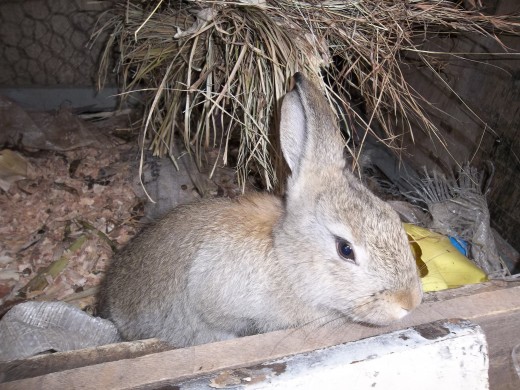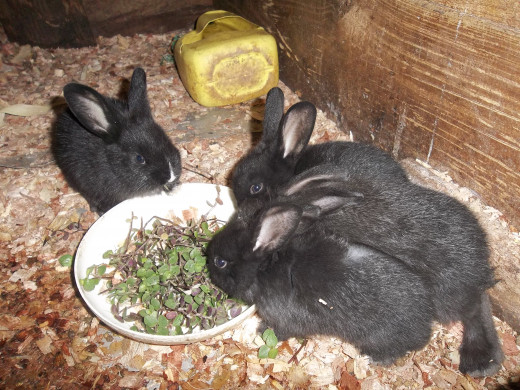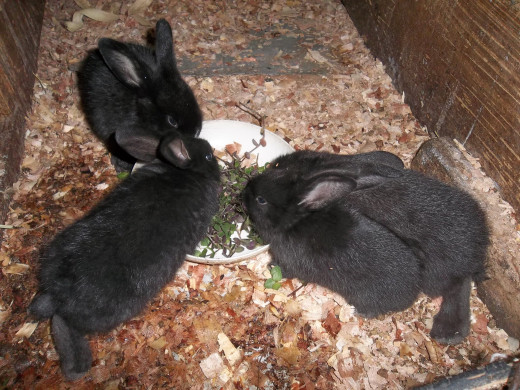Rabbit Farming in Kenya: How to Profit from the Growing Demand
Rabbit keeping in Kenya
Information just in is that rabbit meat in Kenya will soon be big business. There are international orders running in tonnes. According to a recent article in the press, even if all the rabbits in Kenya are slaughtered, Kenya cannot meet the demand of only one country—France. This means that there is great potential in this form of animal husbandry because soon Kenyans will have a taste for rabbit meat and there will not be enough to go around, unless, of course, more people start keeping them for profit. When compared to chickens, rabbits have a wide range of food.
Besides the commercial pellets, which they must be fed on if they are to gain the much-needed weight, rabbits will also eat kale, cabbage, sweet potato vines, pods from peas, and many other greens that are seen as weeds in the gardens. I give my rabbits the waste from vegetable vendors to supplement the pellets too and the variety is enormous. You need to be careful with this 'waste,’ however. I wash them with plain water first to get rid of solid dirt, and then I rinse them in salt water to kill bacteria and other organisms. Next, I dry them out in the sun for further disinfecting, besides ensuring that they stay fresh for longer.
Where will you get your breeding stock?
There are many people claiming to sell high-breed rabbits in Kenya online. If you already have an idea about the breed you want to keep, then you can take a chance with these online merchants. If you have no idea about rabbits, it may be risky buying from a contact you met online. For one you will have to accept that the “New Zealand White” on offer is what it is. Not all white rabbits are New Zealand Whites, so there is the possibility of buying a local or crossbreed unwittingly.
The Kenya Agricultural Research Institute (KARI) has a station in Ngong dedicated to rabbit rearing. They give free advice to farmers and sell their high breeds complete with records of ‘sires’ (fathers) and ‘dams’ (mothers) of the weaned kids to avoid in breeding when you acquire stock from them. In other words, they will not sell to you rabbits that have the same father or mother if your objective is to breed.
The Ngong station also organises three-day seminars for new rabbit farmers. By the end of the seminar, the farmer has knowledge on diet, diseases, and marketing, including how to slaughter and cook rabbit meat.
Which breeds can I find at KARI
New Zealand White
Chinchila
ILRI Grey (International Livestock Research Institute)
California White
Flemish Giant
Checkered Giant
Dutch
French Lop
Information just in is that rabbit meat in Kenya will soon be big business. There are international orders running in tonnes. According to a recent article in the press, even if all the rabbits in Kenya are slaughtered, Kenya cannot meet the demand of only one country—France. This means that there is great potential in this form of animal husbandry because soon Kenyans will have a taste for rabbit meat and there will not be enough to go around, unless, of course, more people start keeping them for profit. When compared to chickens, rabbits have a wide range of food.
Besides the commercial pellets, which they must be fed on if they are to gain the much-needed weight, rabbits will also eat kale, cabbage, sweet potato vines, pods from peas, and many other greens that are seen as weeds in the gardens. I give my rabbits the waste from vegetable vendors to supplement the pellets too and the variety is enormous. You need to be careful with this 'waste,’ however. I wash them with plain water first to get rid of solid dirt, and then I rinse them in salt water to kill bacteria and other organisms. Next, I dry them out in the sun for further disinfecting, besides ensuring that they stay fresh for longer.
Where will you get your breeding stock?
There are many people claiming to sell high-breed rabbits in Kenya online. If you already have an idea about the breed you want to keep, then you can take a chance with these online merchants. If you have no idea about rabbits, it may be risky buying from a contact you met online. For one you will have to accept that the “New Zealand White” on offer is what it is. Not all white rabbits are New Zealand Whites, so there is the possibility of buying a local or crossbreed unwittingly.
The Kenya Agricultural Research Institute (KARI) has a station in Ngong dedicated to rabbit rearing. They give free advice to farmers and sell their high breeds complete with records of ‘sires’ (fathers) and ‘dams’ (mothers) of the weaned kids to avoid in breeding when you acquire stock from them. In other words, they will not sell to you rabbits that have the same father or mother if your objective is to breed.
The Ngong station also organises three-day seminars for new rabbit farmers. By the end of the seminar, the farmer has knowledge on diet, diseases, and marketing, including how to slaughter and cook rabbit meat.
Which breeds can I find at KARI
New Zealand White
Chinchila
ILRI Grey (International Livestock Research Institute)
California White
Flemish Giant
Checkered Giant
Dutch
French Lop
 |
| A two month old Flemish Giant |
Raising orphaned rabbit babies
The
Chinchilla doe gave birth to eight kits on d13th April. Two looked
rather small and I had doubts about their survival. They died soon
after, followed closely by two more within the first week. The surviving
four were in good health and by the end of the second week, they were
moving energetically about in their nesting box. The mother would have
no problem raising four kits; less pressure and more milk. Who would
have expected the mother, a big full grown Chinchilla to die suddenly in
the third week. Unfortunately for me and the kits, that is what
happened. However, I was more concerned about the kits than the loss of a
pure breed Chinchilla in monetary terms. The risk of losing all the
four healthy and bouncing kits was very real. Though I had noticed that
they had started to help their mother eat her pellets, I doubted that
they could survive on pellets alone without the nutritious milk that she
had been affording them.
That in evening , I put some pellets in a tray for them to eat but they did not come close. I hoped that they would eat some of it at night. In the meantime I remembered a stray rabbit that used to break into my compound with her kits to feed on an ornamental ground cover that I had planted. I used to really get annoyed at the stray for the destruction but in retrospect, nature was teaching me a lesson. Her kits were about the same size as the orphaned ones and so I decided that at day break, I would try to give them some of the 'ground cover' as my plan B. My plan A was to catch one of the other nursing mothers, hold her firmly and bring the orphans for some breast feeding.
That in evening , I put some pellets in a tray for them to eat but they did not come close. I hoped that they would eat some of it at night. In the meantime I remembered a stray rabbit that used to break into my compound with her kits to feed on an ornamental ground cover that I had planted. I used to really get annoyed at the stray for the destruction but in retrospect, nature was teaching me a lesson. Her kits were about the same size as the orphaned ones and so I decided that at day break, I would try to give them some of the 'ground cover' as my plan B. My plan A was to catch one of the other nursing mothers, hold her firmly and bring the orphans for some breast feeding.

Day 2 - I find the the pellets given last evening have not been eaten. The kits must be hungry.
I get help to hold the selected nursing mother and bring the orphans. They struggle to get away from their reluctant foster mother. They already know it is not their mother and the plan fails. I have to go to plan B.
I gather a handful of the ground cover and offer them. They gobble them all up. That is a good sign. I am however not sure how much is good for them and how much would be detrimental. I settle on the handful for now but leave the pellets in their cage. Water is available at all times.
In the evening I find that the pellets have all been eaten up. Good. But that will do for one day. Over eating for young rabbits can cause death, I remind myself. They can wait for some 'ground cover' in the morning.
Day 3 - a handful of 'ground cover' in the morning, 100 grams of pellets for all of them in the evening.
Day 5 - the kits are bouncy and healthy on a diet of a handful of 'ground cover' and 100 grams of pellets daily. They now consider me their foster mother. They come close when they hear my movement and even allow me to touch them. I have been lacking hay for some time now but I got some today. I throw in a sizable bunch for them to nibble on demand. They seem out of danger.
I get help to hold the selected nursing mother and bring the orphans. They struggle to get away from their reluctant foster mother. They already know it is not their mother and the plan fails. I have to go to plan B.
I gather a handful of the ground cover and offer them. They gobble them all up. That is a good sign. I am however not sure how much is good for them and how much would be detrimental. I settle on the handful for now but leave the pellets in their cage. Water is available at all times.
In the evening I find that the pellets have all been eaten up. Good. But that will do for one day. Over eating for young rabbits can cause death, I remind myself. They can wait for some 'ground cover' in the morning.
Day 3 - a handful of 'ground cover' in the morning, 100 grams of pellets for all of them in the evening.
Day 5 - the kits are bouncy and healthy on a diet of a handful of 'ground cover' and 100 grams of pellets daily. They now consider me their foster mother. They come close when they hear my movement and even allow me to touch them. I have been lacking hay for some time now but I got some today. I throw in a sizable bunch for them to nibble on demand. They seem out of danger.
Explore more insights on sustainable farming and environmental solutions: ✅ ✅ ✅ ✅
If you enjoyed this piece and would like to support more reflections like it, feel free to Buy Me a Coffee. Your support helps keep Kenya’s voices and stories alive.




Comments
Post a Comment
Your comments are very important to this blog. Feel very free to make your opinion known. We will respect it.